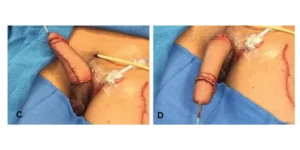Understanding Penis Phalloplasty: A Complete Guide to Surgical Techniques, Benefits, Risks & Recovery
1. What is Penis Phalloplasty?
Penis Phalloplasty is a surgical technique used to create a penis, often as part of gender-affirming procedures or to restore anatomy following trauma or congenital abnormalities. The main objective is to construct a penis that not only looks natural but also meets the individual’s functional and personal goals. For transgender men, this procedure plays a pivotal role in aligning their body with their gender identity. For others, it’s a reconstructive step to restore function and appearance after accidents or birth defects.
2. Understanding Penis Phalloplasty surgery
What is Phalloplasty?
In simple terms, phalloplasty is a surgery to create or reconstruct a penis. It is commonly performed for two main reasons: gender-affirming surgery for transgender men and reconstructive surgery for individuals with injuries or congenital conditions like micropenis.
The surgery involves creating a new penis with tissue grafted from another part of the body, such as the forearm or thigh. It can also involve creating a functional urethra for urination and adding prosthetics for sexual function.
Indications for Phalloplasty
Phalloplasty is recommended in the following cases:
- Gender-affirming surgery: Transgender men may seek phalloplasty to have a penis that aligns with their gender identity.
- Reconstructive surgery: Individuals who have lost their penis due to injury or congenital conditions may opt for phalloplasty to restore function and appearance.
Before undergoing phalloplasty, it’s important to discuss the procedure with a skilled surgeon who can assess the best approach for your specific needs.
👉 Learn step by step how to use Pro Extender safely and effectively for the best results.
Penis Phalloplasty Techniques
Phalloplasty can be done using a variety of surgical methods, depending on a person’s anatomy, goals, and preferences. Two of the most commonly used techniques include:
- Radial Forearm Flap (RFF): This approach involves taking skin, fat, and other tissue from the forearm to create the phallus. It’s widely used, especially among transgender men, due to its reliable results and the ability to construct a sensate penis.

- Anterolateral Thigh Flap (ALT): This technique uses tissue from the thigh and is often chosen by individuals who want to avoid a visible scar on the arm. It provides enough bulk and can be a good option for those with sufficient thigh tissue.
In some cases, surgeons may use tissue from the abdomen or combine various methods to achieve the best outcome. The choice of technique is highly individualized and thoroughly discussed during pre-surgical consultations.

3. Benefits of Penis Phalloplasty
Improved Physical Appearance
One of the main benefits of phalloplasty is the improvement in physical appearance. For transgender men, having a penis that matches their gender identity can greatly boost self-esteem and body image. For those who need reconstructive surgery due to injury or congenital conditions, phalloplasty can restore confidence by providing a functional and natural-looking penis.
Imagine feeling more comfortable in your own body, where your physical appearance matches how you feel inside. This change can be truly life-changing.
Functional Restoration
Phalloplasty also restores function, which is crucial for many individuals. After the surgery, many people regain normal urinary function, allowing them to urinate in a typical manner. In some cases, prosthetic implants can be added later to restore sexual function.
For individuals with gender dysphoria, regaining this functionality can be a major relief, as it allows them to live in alignment with their gender identity in everyday life.
Psychosocial Benefits
Phalloplasty doesn’t just bring about physical transformation—it can also greatly enhance mental well-being. For many, the procedure helps boost self-confidence and ease feelings of gender dysphoria. Aligning one’s physical appearance with their gender identity often leads to a more fulfilling and balanced life.
Research also indicates that those who choose gender-affirming surgeries like phalloplasty tend to feel more at ease with their bodies and report lower levels of anxiety.
Life-Changing Impact for Transgender Individuals
For transgender men, phalloplasty is life-changing. It helps them align their body with their gender identity, leading to increased self-confidence and emotional well-being. Many transgender men report that phalloplasty has significantly improved their quality of life, helping them feel more at home in their own bodies.
4: Risks and Side Effects of Penis Phalloplasty
Common Risks
Like any major surgery, phalloplasty comes with risks. Common risks include:
- Infection: Skin grafts and other surgical sites can become infected, so proper care is essential.
- Bleeding: Excessive bleeding, although rare, can occur after surgery.
It’s important to follow all post-operative care instructions to minimize these risks and ensure a smooth recovery.
Long-Term Side Effects
Some long-term side effects of penis phalloplasty can include:
- Scarring: There will be some scarring at the donor site, which may vary depending on the surgical method.
- Reduced Sensation: In some cases, sensation in the new penis may be reduced, which could affect sexual pleasure.
- Complications with Prosthetics: If prosthetic implants are used, there may be issues such as malfunction or discomfort.
Urinary Issues
There may be some difficulty with urination after penis phalloplasty. Problems like urinary retention or misalignment of the urethra are possible. These issues are typically addressed through follow-up procedures or adjustments.
Need for Multiple Surgeries
Penis phalloplasty is often performed in stages, meaning multiple surgeries may be required to complete the process. These stages might include creating the penis, constructing the urethra, and adding prosthetic implants.
While it’s a multi-step process, the end result is a carefully customized, functional, and aesthetic outcome.
Psychological Impact of Complications
While phalloplasty can be life-changing, complications during recovery can have emotional effects. It’s important to seek emotional support if any issues arise, such as dissatisfaction with the results or complications during recovery.
Counseling, support groups, and therapy are valuable resources during this time.
5: Recovery Process After Penis Phalloplasty
Post-Surgery Care
After phalloplasty, recovery begins with a hospital stay for monitoring and pain management. During this time, it’s essential to follow post-surgery care instructions, including keeping the surgical area clean and managing any catheters.
Recovery Timeline
The recovery timeline varies, but here’s what you can generally expect:
- First few weeks: Rest and pain management.
- 3-6 months: Swelling and bruising may persist, but significant healing occurs.
- 6-12 months: Full results become visible, with possible additional surgeries for prosthetic implants.
Conclusion
Balancing the Benefits and Risks
Penis phalloplasty can offer life-changing benefits such as enhancing one’s physical appearance, restoring certain functions, and alleviating gender dysphoria. At the same time, like any major surgery, it involves potential risks, including infection and complications that should not be overlooked.
Important Considerations Before Surgery
anyone thinking about phalloplasty should take a thoughtful look at their overall health, emotional support network, and what they realistically hope to gain from the surgery. Being mentally and physically prepared is just as important as the procedure itself.
Talk to a Qualified Medical Professional
choosing to undergo penis phalloplasty is a big step, and it’s essential to have guidance from a skilled and experienced surgeon. Their expertise can help you understand what’s possible, manage expectations, and make the best decision for your personal well-being.
References
- World Professional Association for Transgender Health (WPATH).
Standards of Care for Gender-Affirming Surgical Procedures, Including Phalloplasty.
https://www.wpath.org/ - American Society of Plastic Surgeons (ASPS).
Phalloplasty Surgery Overview: Techniques, Indications & Recovery Guidelines.
https://www.plasticsurgery.org/ - Cleveland Clinic – Center for Genitourinary Reconstruction.
Phalloplasty for Transgender Men & Reconstructive Purposes: Risks, Benefits & Surgical Methods.
https://my.clevelandclinic.org/ - Mayo Clinic – Transgender & Reconstructive Surgery Program.
Gender-Affirming Surgical Options, Phalloplasty Techniques & Postoperative Guidance.
https://www.mayoclinic.org/ - Johns Hopkins Medicine – Center for Transgender and Gender Expansive Health.
Phalloplasty for Gender-Affirming Care: Surgical Approaches & Long-Term Outcomes.
https://www.hopkinsmedicine.org/ - UCSF Transgender Care – University of California San Francisco.
Phalloplasty Guide: Surgical Steps, Risks, Urinary Reconstruction & Recovery Timeline.
https://transcare.ucsf.edu/ - American Urological Association (AUA).
Urologic Reconstruction, Urethral Lengthening & Post-Surgical Complications in Phalloplasty.
https://www.auanet.org/ - European Association of Urology (EAU).
Genital Reconstruction Guidelines & Best Practices for Gender-Affirming Surgery.
https://uroweb.org/guidelines/ - National Institutes of Health – National Library of Medicine (NIH/NLM).
Clinical Outcomes & Complications of Phalloplasty Surgical Techniques (Peer-Reviewed Articles).
https://www.ncbi.nlm.nih.gov/ - Journal of Sexual Medicine.
Evidence-Based Review: Sensation, Function, Prosthetic Implant Outcomes & Psychosocial Impact of Phalloplasty.
https://www.jsm.jsexmed.org/ - British Association of Plastic, Reconstructive and Aesthetic Surgeons (BAPRAS).
Microsurgery Techniques, Donor Site Morbidity & Flap Selection in Phalloplasty.
https://www.bapras.org.uk/ - Transgender Health Journal – Mary Ann Liebert Inc.
Mental Health Outcomes, Satisfaction Levels & Quality of Life Improvements After Phalloplasty.
https://www.liebertpub.com/


